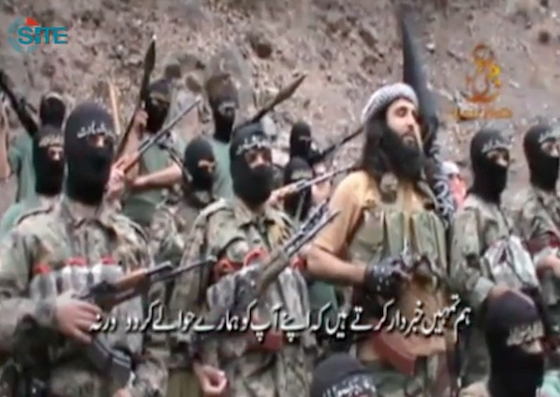|
|
|
Adnan Rasheed (unmasked) is pictured with members of his “death squad.” Image from the SITE Intelligence Group. |
During a raid in South Waziristan, the Pakistani military reportedly captured Adnan Rasheed, a Taliban commander who was broken out of prison in 2012. An al Qaeda commander known as Mufti Zubair Marwat was also arrested in the raid.
Rasheed, Marwat, and two guards are said to have been captured on July 10 in the Shakai valley in South Waziristan, according to Dawn. Rasheed is thought to have been wounded.
Marwat “is the brother of Mufti Sajjad Marwat – an al Qaeda spokesman for Afghanistan and Pakistan,” Dawn reported.
The reports of their capture has not been publicly confirmed by the Pakistani military, however.
If Rasheed’s capture is confirmed, he will be the first big-name Taliban commander to have been killed or captured by the Pakistani military since it launched an offensive in North Waziristan on June 15. The Pakistan military has claimed to have killed more than 400 terrorists, but has not named any of them.
Rasheed is currently the emir of the Ansar al Aseer Khorasan (“Helpers of the Prisoners”), a group that includes members from the Islamic Movement of Uzbekistan and the Taliban and was founded to free jihadists from Pakistani prisons.
Rasheed has a long history with Pakistani terrorist groups as well as al Qaeda. He was involved in the Dec. 14, 2003 assassination attempt against then-President Pervez Musharraf. A member of the Pakistani Air Force, Rasheed was sentenced to death for his role in the assassination attempt, but the sentence was never carried out. While in prison, Rasheed owned several cell phones and frequently communicated with journalists. He also got married while in prison and fathered a child.
Rasheed worked for Amjad Farooqi, the Pakistani terrorist who engineered the two assassination attempts against Musharraf in December 2003 at the behest of al Qaeda leader Abu Faraj al Libi; Farooqi is suspected of involvement in other terror attacks as well. Farooqi was a member of the Sipah-e-Sahaba Pakistan; the Harkat-ul-Ansar and its successor, the Harakat-ul-Mujahideen; Harakat-ul-Jihad-al-Islami; and Jaish-e-Mohammed. He served as a close aide to Qari Saifullah Akhtar, the leader of the Harakat-ul-Jihad-al-Islami. In addition, Farooqi served as the group’s representative to al Qaeda’s International Islamic Front, which issued the 1998 fatwa that declared war on the US.
On April 15, 2012, the Movement of the Taliban in Pakistan launched a successful operation to free Rasheed and nearly 400 prisoners, including an estimated 200 Taliban fighters and jihadists, being held at a prison in Bannu. The operation was directed by Hakeemullah Mehsud, the former emir of the Movement of the Taliban in Pakistan, and Waliur Rehman Mehsud, the group’s former emir for South Waziristan (both Hakeemullah and Waliur Rehman were killed by the US in drone strikes). More than 150 fighters assaulted the prison. Rasheed was later featured in a videotape celebrating the jailbreak.
Since the Bannu jailbreak, Rashid has featured in several Taliban propaganda tapes. In January 2013, he appeared in a joint Taliban and Islamic Movement of Uzbekistan video that announced the formation of the Ansar al Aseer. The video also featured Yassin Chouka, a wanted German commander in the Islamic Movement of Uzbekistan; and Abdul Hakeem, a Russian IMU member.
In March 2013, Rasheed released a video in which he claimed to have formed an assassination squad to kill former President Musharraf. Rasheed said the “death squad” is split up in groups of “fedayeen, sniper team, special assault team, and close combat team.” The term ‘fedayeen’ is often used to describe suicide bombers.
Are you a dedicated reader of FDD's Long War Journal? Has our research benefitted you or your team over the years? Support our independent reporting and analysis today by considering a one-time or monthly donation. Thanks for reading! You can make a tax-deductible donation here.








